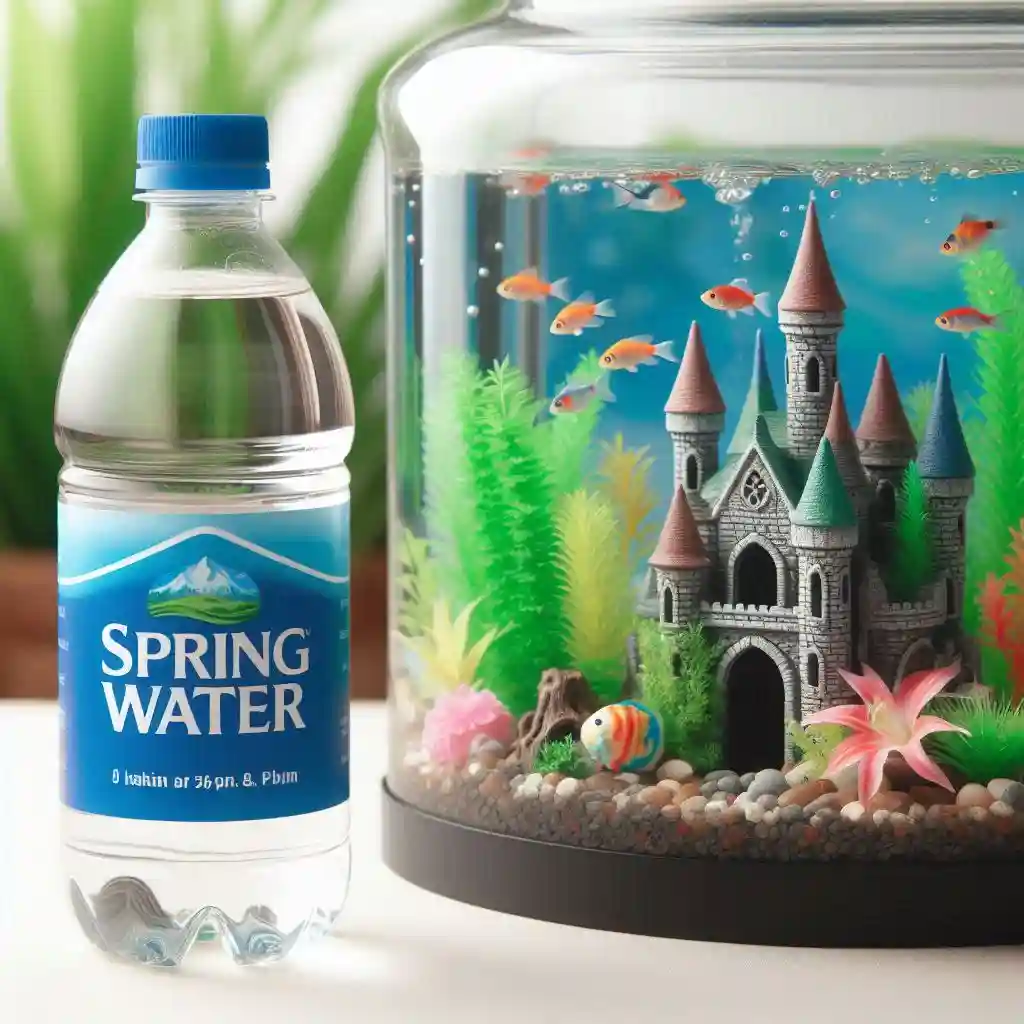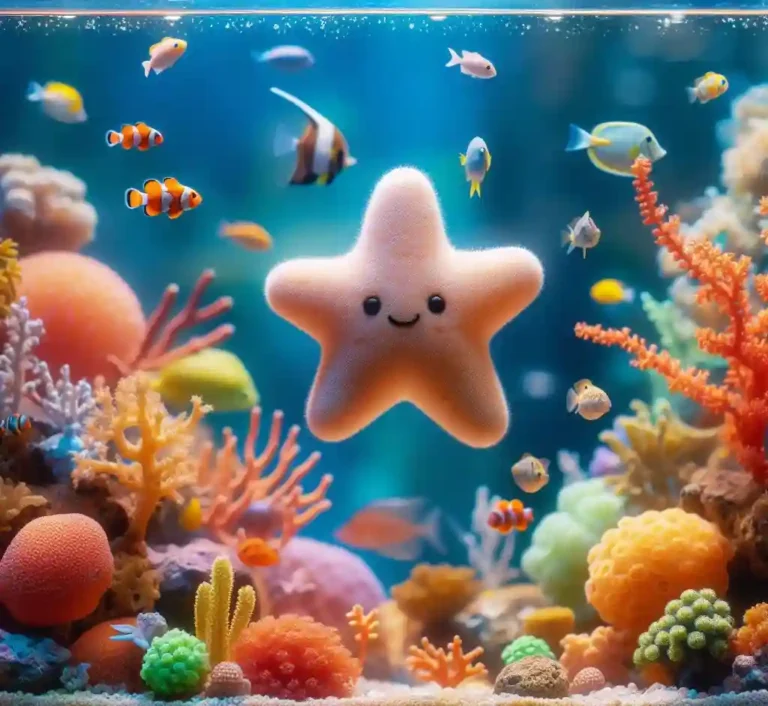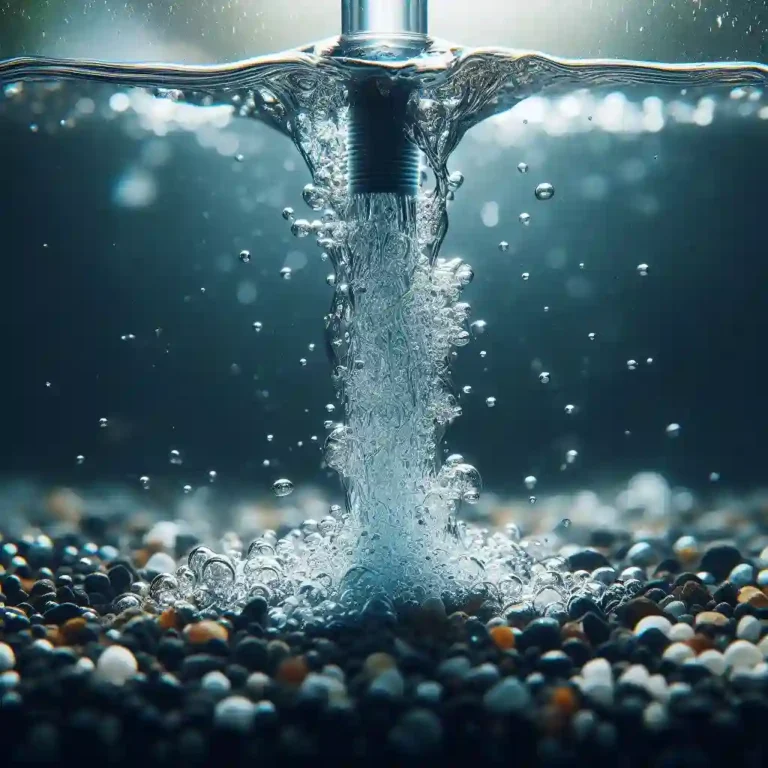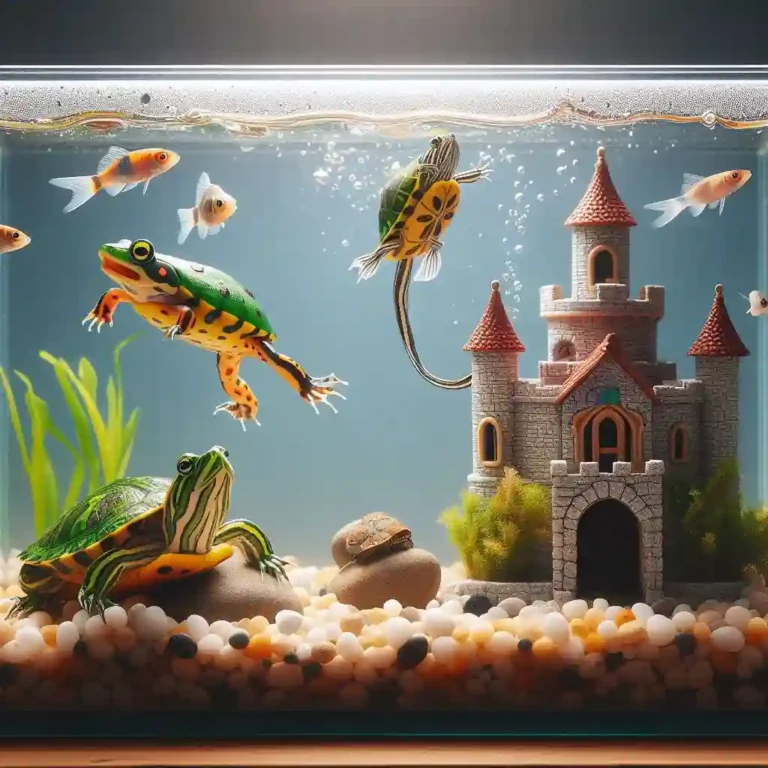Spring Water for Fish Tank: A Guide to Improving Water Quality
Spring Water for Fish Tank: While many aquarium enthusiasts swear by the benefits of using spring water for their fish tanks, others may be skeptical about the idea.
But what exactly is spring water, and how can it benefit your finned friends?
In this guide, we’ll dive into the world of spring water and explore the advantages and considerations of using it in your fish tank.
Spring Water for Fish Tank: A Quick Guide

Why Spring Water?
Spring water is a popular choice for fish tanks because it’s naturally filtered and contains beneficial minerals that can benefit your fish. Spring water is often rich in calcium, magnesium, and other essential minerals that can help strengthen your fish’s scales and promote healthy growth.
Benefits of Spring Water for Fish Tanks:
- Natural Filtration: Spring water is filtered naturally through the earth, which can reduce the need for chemical treatments and maintain a healthy balance of beneficial bacteria.
- Mineral-Rich: Spring water contains essential minerals like calcium, magnesium, and potassium that can benefit your fish’s health and well-being.
- pH Stability: Spring water tends to have a stable pH level, which can help maintain a healthy environment for your fish.
- Less Maintenance: Spring water can reduce the need for frequent water changes and water treatments.
How to Use Spring Water for Your Fish Tank:
- Choose a Reputable Source: Select a spring water brand that is specifically designed for aquarium use and has a good reputation among aquarists.
- Start with a Small Amount: Begin by mixing a small amount of spring water with your regular tank water to acclimate your fish to the new water.
- Monitor Water Parameters: Regularly test your tank’s water parameters, such as pH, ammonia, and nitrite levels, to ensure the spring water is not causing any adverse effects.
- Gradually Increase the Ratio: Gradually increase the proportion of spring water in your tank over time to minimize any potential stress on your fish.
- Maintain Regular Maintenance: Continue to perform regular water changes and maintenance to ensure the overall health and well-being of your fish.
Important Considerations:
- pH Compatibility: Make sure the pH of the spring water is compatible with your tank’s pH level to avoid shocking your fish.
- Water Hardness: Spring water can be harder or softer than your tank water, which may affect your fish’s health. Monitor your fish’s behavior and adjust the water hardness accordingly.
- Fish Acclimation: Always acclimate your fish to the new water gradually to prevent stress and disease.
What Makes Spring Water Ideal for Fish Tanks?

1. Natural Mineral Profile
Spring water is naturally rich in minerals such as calcium, magnesium, and potassium, which are essential for the health and well-being of your fish. These minerals help to maintain strong bones, scales, and fins, and can even help to prevent diseases.
2. Neutral pH
Spring water typically has a neutral pH, which is ideal for most freshwater fish. This helps to reduce stress and prevent pH-related health issues.
3. Low in Heavy Metals
Spring water is often naturally filtered through the earth, which removes impurities and heavy metals that can be toxic to fish. This reduces the risk of metal poisoning and other health problems.
4. Free from Chlorine and Chloramines
Unlike tap water, spring water is free from chlorine and chloramines, which can be toxic to fish even in small quantities.
5. Stable Water Parameters
Spring water tends to have stable water parameters, which helps to reduce stress and prevent sudden changes that can harm your fish.
6. Natural Beneficial Bacteria
Spring water often contains natural beneficial bacteria, which can help to break down waste and maintain a healthy biological balance in your tank.
7. No Added Chemicals
Spring water is free from added chemicals, such as fluoride and phosphates, which can be harmful to fish and other aquatic life.
The Dangers of Tap Water for Fish Tanks
1. Chlorine and Chloramines
Tap water often contains chlorine and chloramines, which are added to kill bacteria and other microorganisms. However, these chemicals can be toxic to fish, even in small quantities. Prolonged exposure can cause respiratory problems, skin irritation, and even death.
2. Heavy Metals
Tap water can contain heavy metals like lead, copper, and zinc, which can be toxic to fish. These metals can accumulate in the tank and cause a range of health problems, from fin damage to organ failure.
3. pH Imbalance
Tap water can have a high or low pH, which can cause stress and discomfort for your fish. Sudden changes in pH can even cause death.
4. Nitrates and Nitrites
Tap water can contain high levels of nitrates and nitrites, which can fuel algae growth and create an unhealthy environment for your fish.
5. Fluoride and Phosphates
Tap water often contains fluoride and phosphates, which can be harmful to fish and other aquatic life. Fluoride can cause skeletal deformities, while phosphates can contribute to algae blooms.
6. Unstable Water Parameters
Tap water can have unstable water parameters, including temperature, pH, and hardness, which can cause stress and discomfort for your fish.
7. Bacterial Contamination
Tap water can contain bacteria, viruses, and other microorganisms that can infect your fish and cause disease.
8. Lack of Beneficial Minerals
Tap water often lacks the beneficial minerals and nutrients found in natural spring water, which can lead to deficiencies and health problems in your fish.
How to Choose the Right Spring Water for Your Fish Tank

1. Source and Origin
Look for spring water sourced from a natural, underground aquifer or spring. Avoid spring water that is sourced from surface water or treated with chemicals.
2. Mineral Profile
Choose a spring water with a balanced mineral profile that is similar to the natural environment of your fish. Look for water with a pH between 6.5 and 8.5, and a total hardness (GH) between 5-15 dGH.
3. Bacterial Content
Opt for spring water with a natural bacterial content, which can help to break down waste and maintain a healthy biological balance in your tank.
4. Nitrate and Nitrite Levels
Select a spring water with low nitrate and nitrite levels to prevent algae growth and maintain a healthy environment for your fish.
5. Certification and Testing
Look for spring water that is certified by a reputable third-party organization, such as the International Bottled Water Association (IBWA) or the National Sanitation Foundation (NSF). Check for regular water quality testing and reporting.
6. Packaging and Storage
Choose spring water that is packaged in food-grade containers and stored in a clean, dry environment to prevent contamination.
7. Brand Reputation and Transparency
Research the brand’s reputation, customer reviews, and transparency about their sourcing, testing, and treatment processes.
8. Cost and Convenience
Consider the cost and convenience of the spring water, including delivery options, storage requirements, and ease of use.
The Benefits of Using Spring Water for Fish Health
1. Improved Water Quality
Spring water is naturally filtered and purified, which means it is free from many of the contaminants and pollutants found in tap water. This results in a cleaner, healthier environment for your fish.
2. Reduced Stress
The stable pH and mineral profile of spring water can help to reduce stress in fish, which can lead to a range of health problems.
3. Stronger Immune System
The natural minerals and electrolytes in spring water can help to support a strong immune system in fish, making them more resilient to disease.
4. Healthier Scales and Fins
The minerals in spring water, such as calcium and magnesium, can help to promote healthy scales and fins in fish.
5. Reduced Risk of Disease
The lack of chlorine, chloramines, and heavy metals in spring water reduces the risk of disease in fish, including respiratory problems and skin irritations.
6. Improved Digestion
The natural balance of minerals in spring water can help to support healthy digestion in fish, reducing the risk of digestive problems.
7. Increased Energy
The electrolytes and minerals in spring water can help to increase energy levels in fish, leading to more active and vibrant behavior.
8. Better Coloration
The natural minerals in spring water can help to enhance the natural coloration of fish, making them more vibrant and attractive.
9. Longer Lifespan
By providing a healthy, stable environment, spring water can help to increase the lifespan of fish, allowing them to thrive for years to come.
10. Reduced Maintenance
Using spring water can reduce the need for frequent water changes and maintenance, making it easier to care for your fish.
Spring Water vs. RO/DI Water: Which is Best for Fish Tanks?
Spring Water:
- Natural Mineral Profile: Spring water contains a natural balance of minerals and electrolytes that are essential for fish health.
- Stable pH: Spring water typically has a stable pH, which reduces the risk of sudden changes that can stress fish.
- Beneficial Bacteria: Spring water can contain beneficial bacteria that help to break down waste and maintain a healthy biological balance in the tank.
RO/DI Water:
- Purified Water: RO/DI water is purified to remove impurities and contaminants, making it a good option for fish that require very pure water.
- Customizable: RO/DI water can be customized to meet the specific needs of your fish, including pH, hardness, and mineral content.
- Consistent Quality: RO/DI water is consistently pure and free from contaminants, making it a good option for sensitive fish.
Comparison:
- Mineral Content: Spring water contains a natural balance of minerals, while RO/DI water can be customized to meet specific mineral requirements.
- pH Stability: Spring water typically has a stable pH, while RO/DI water can be adjusted to meet specific pH requirements.
- Beneficial Bacteria: Spring water can contain beneficial bacteria, while RO/DI water is typically sterile.
How to Cycle Your Fish Tank with Spring Water
Step 1: Prepare Your Tank
- Set up your tank and equipment according to the manufacturer’s instructions.
- Rinse all decorations and gravel thoroughly before adding them to the tank.
Step 2: Add Spring Water
- Use a high-quality spring water that is certified by a reputable third-party organization.
- Add the spring water to the tank, making sure to remove any chlorine or chloramines.
- Use a water conditioner to remove any heavy metals or other impurities.
Step 3: Add Beneficial Bacteria
- Add beneficial bacteria supplements to the tank to establish a healthy biological balance.
- These supplements can be in the form of bacteria cultures, bio-media, or other products specifically designed for aquarium use.
Step 4: Monitor Water Parameters
- Monitor water parameters such as ammonia, nitrite, and nitrate levels regularly.
- Use a water test kit to ensure that the water is safe for your fish.
Step 5: Introduce Fish
- Once the tank is cycled and water parameters are stable, you can introduce your fish to the tank.
- Start with a few hardy fish and gradually add more fish over time.
Tips for Cycling Your Tank with Spring Water:
- Use a high-quality spring water that is certified by a reputable third-party organization.
- Monitor water parameters regularly to ensure stability and make adjustments as needed.
- Consider adding beneficial bacteria supplements to maintain a healthy biological balance.
- Be patient and don’t rush the cycling process, as this can lead to unstable water parameters and stress on your fish.
Tips for Maintaining Optimal Water Quality with Spring Water
1. Regular Water Changes
- Regular water changes are essential for maintaining optimal water quality.
- Change 10-20% of the tank water weekly to remove waste products and maintain water quality.
2. Monitor Water Parameters
- Monitor water parameters such as pH, ammonia, nitrite, and nitrate levels regularly.
- Use a water test kit to ensure that the water is safe for your fish.
3. Maintain a Balanced Biological Load
- Ensure that the biological load of your tank is balanced by not overstocking the tank.
- Monitor the tank’s biological load by tracking the amount of waste produced by your fish.
4. Provide Adequate Filtration
- Provide adequate filtration to remove waste products and maintain water quality.
- Use a high-quality filter that is designed for your tank size and type.
5. Avoid Overfeeding
- Avoid overfeeding your fish, as this can lead to excess waste and poor water quality.
- Only feed your fish as much as they can consume within a few minutes.
6. Add Beneficial Bacteria
- Add beneficial bacteria supplements to the tank to maintain a healthy biological balance.
- These supplements can help to break down waste products and maintain water quality.
7. Avoid Using Chemicals
- Avoid using chemicals such as chlorine and chloramines, which can harm your fish and affect water quality.
- Instead, use natural methods to maintain water quality, such as adding beneficial bacteria supplements.
8. Perform Regular Tank Maintenance
- Perform regular tank maintenance, such as cleaning the gravel and decorations, to maintain water quality.
- Remove any debris or waste products that can affect water quality.
Common Misconceptions About Using Spring Water in Fish Tanks
Misconception 1: Spring Water is Always Better
- Not all spring water is created equal. Some spring water may contain high levels of minerals or other contaminants that can harm your fish.
Misconception 2: Spring Water is Always Safe for Fish
- While spring water can be a great choice for fish tanks, it’s not always safe for all fish. Some fish may be sensitive to the minerals or other compounds found in spring water.
Misconception 3: Spring Water is Always Cheaper
- While spring water may be cheaper than other types of water, it’s not always the cheapest option. Some spring water may be more expensive than other types of water.
Misconception 4: Spring Water is Always Better for Fish
- While spring water can be a great choice for fish tanks, it’s not always the best option for all fish. Some fish may be better suited to other types of water.
Misconception 5: Spring Water is Always Easy to Use
- While spring water can be easy to use in fish tanks, it’s not always the case. Some spring water may require special equipment or treatment to make it safe for fish.
Misconception 6: Spring Water is Always the Best Choice
- While spring water can be a great choice for fish tanks, it’s not always the best option. Other types of water may be better suited to your specific fish and tank.
FAQs
Q: What is the best way to use spring water in my fish tank?
A: The best way to use spring water in your fish tank is to use a high-quality spring water that is certified by a reputable third-party organization. Make sure to monitor water parameters regularly to ensure stability and make adjustments as needed.
Q: Can I use spring water with all types of fish?
A: Not all fish are suitable for spring water. Some fish may be sensitive to the minerals or other compounds found in spring water. Research the specific needs of your fish to determine if spring water is suitable for them.
Q: Is spring water always better than tap water?
A: Not always. While spring water can be a great choice for fish tanks, it’s not always the best option. Tap water can be a good choice for some fish, and other types of water may be better suited to your specific fish and tank.
Q: How do I know if my spring water is high-quality?
A: Look for certifications from reputable third-party organizations, such as the International Bottled Water Association (IBWA) or the National Sanitation Foundation (NSF). Also, check the label for information about the water’s mineral content and pH level.
Q: Can I use spring water with a saltwater tank?
A: No, spring water is not suitable for saltwater tanks. Saltwater tanks require a specific type of water that is designed for saltwater aquariums.
Q: How do I cycle my tank with spring water?
A: To cycle your tank with spring water, add the spring water to the tank and monitor water parameters regularly. Add beneficial bacteria supplements to the tank to establish a healthy biological balance.
Q: Can I use spring water with a freshwater tank?
A: Yes, spring water can be used with freshwater tanks. However, make sure to monitor water parameters regularly to ensure stability and make adjustments as needed.
Q: How do I know if my fish are healthy and thriving in their tank?
A: Look for signs of healthy fish, such as active swimming, bright colors, and a strong appetite. Monitor water parameters regularly to ensure that the tank is stable and healthy.
Q: Can I use spring water with a community tank?
A: Yes, spring water can be used with community tanks. However, make sure to monitor water parameters regularly to ensure stability and make adjustments as needed.
Q: How do I know if my tank is cycled?
A: A tank is cycled when the biological balance is established and the water parameters are stable. Monitor water parameters regularly to ensure that the tank is cycled.
Q: Can I use spring water with a planted tank?
A: Yes, spring water can be used with planted tanks. However, make sure to monitor water parameters regularly to ensure stability and make adjustments as needed.
Q: How do I know if my fish are stressed in their tank?
A: Signs of stressed fish include rapid breathing, labored swimming, and changes in appetite. Monitor water parameters regularly to ensure that the tank is stable and healthy.
Q: Can I use spring water with a cold-water tank?
A: Yes, spring water can be used with cold-water tanks. However, make sure to monitor water parameters regularly to ensure stability and make adjustments as needed.

Hello, I’m Aria Cooper, the heart and soul behind Swimmy Buddies. As a devoted fish aficionado, I share my aquatic adventures and expertise to inspire your own underwater explorations. 🐠🌊







